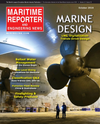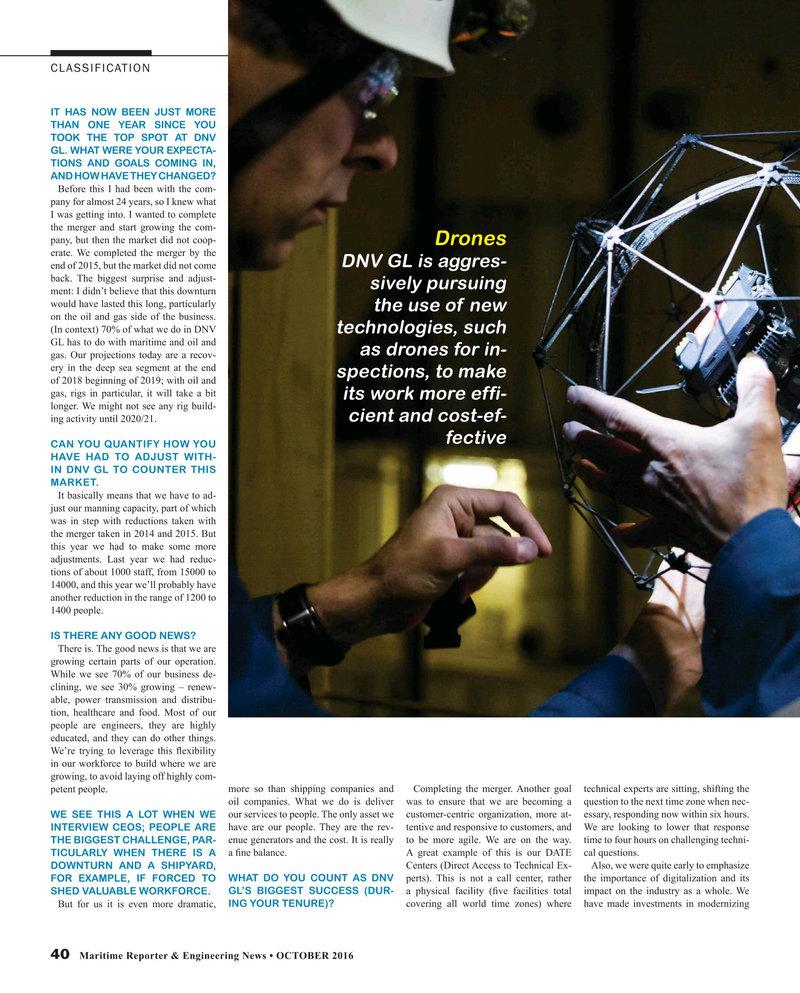
Page 40: of Maritime Reporter Magazine (October 2016)
Marine Design Annual
Read this page in Pdf, Flash or Html5 edition of October 2016 Maritime Reporter Magazine
CLASSIFICATION
IT HAS NOW BEEN JUST MORE
THAN ONE YEAR SINCE YOU
TOOK THE TOP SPOT AT DNV
GL. WHAT WERE YOUR EXPECTA-
TIONS AND GOALS COMING IN,
AND HOW HAVE THEY CHANGED?
Before this I had been with the com- pany for almost 24 years, so I knew what
I was getting into. I wanted to complete the merger and start growing the com- pany, but then the market did not coop-
Drones erate. We completed the merger by the
DNV GL is aggres- end of 2015, but the market did not come back. The biggest surprise and adjust- sively pursuing ment: I didn’t believe that this downturn would have lasted this long, particularly the use of new on the oil and gas side of the business. (In context) 70% of what we do in DNV technologies, such
GL has to do with maritime and oil and as drones for in- gas. Our projections today are a recov- ery in the deep sea segment at the end spections, to make of 2018 beginning of 2019; with oil and gas, rigs in particular, it will take a bit its work more effi- longer. We might not see any rig build- cient and cost-ef- ing activity until 2020/21.
fective
CAN YOU QUANTIFY HOW YOU
HAVE HAD TO ADJUST WITH-
IN DNV GL TO COUNTER THIS
MARKET.
It basically means that we have to ad- just our manning capacity, part of which was in step with reductions taken with the merger taken in 2014 and 2015. But this year we had to make some more adjustments. Last year we had reduc- tions of about 1000 staff, from 15000 to 14000, and this year we’ll probably have another reduction in the range of 1200 to 1400 people.
IS THERE ANY GOOD NEWS?
There is. The good news is that we are growing certain parts of our operation.
While we see 70% of our business de- clining, we see 30% growing – renew- able, power transmission and distribu- tion, healthcare and food. Most of our people are engineers, they are highly educated, and they can do other things.
We’re trying to leverage this ? exibility in our workforce to build where we are growing, to avoid laying off highly com- petent people. more so than shipping companies and Completing the merger. Another goal technical experts are sitting, shifting the oil companies. What we do is deliver was to ensure that we are becoming a question to the next time zone when nec-
WE SEE THIS A LOT WHEN WE our services to people. The only asset we customer-centric organization, more at- essary, responding now within six hours.
INTERVIEW CEOS; PEOPLE ARE have are our people. They are the rev- tentive and responsive to customers, and We are looking to lower that response
THE BIGGEST CHALLENGE, PAR- enue generators and the cost. It is really to be more agile. We are on the way. time to four hours on challenging techni-
TICULARLY WHEN THERE IS A a ? ne balance. A great example of this is our DATE cal questions.
DOWNTURN AND A SHIPYARD, Centers (Direct Access to Technical Ex- Also, we were quite early to emphasize
FOR EXAMPLE, IF FORCED TO WHAT DO YOU COUNT AS DNV perts). This is not a call center, rather the importance of digitalization and its
SHED VALUABLE WORKFORCE. GL’S BIGGEST SUCCESS (DUR- a physical facility (? ve facilities total impact on the industry as a whole. We
But for us it is even more dramatic, ING YOUR TENURE)? covering all world time zones) where have made investments in modernizing 40 Maritime Reporter & Engineering News • OCTOBER 2016
MR #10 (34-41).indd 40 10/4/2016 4:07:23 PM

 39
39

 41
41
